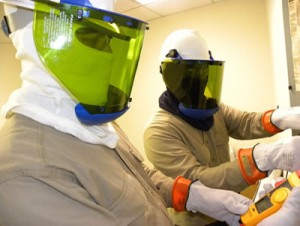KTR can assist your company in becoming OSHA compliant by following the recognized Standard in Electrical Safety: NFPA 70E. Follow the three phases listed below. KTR can assist in all three phases of your project.
Call us today to request a proposal 888 Arc 8050 or 610 670 6061
Phase I: Engineering Assessment
Site Assessment (Data Gathering)
- Develop Single Line Diagrams
- Transformer Data (KVA, Voltages, Impedance)
- Conductor Sizes and Lengths
- Relay, Fuse and Circuit Breaker Information
- Electric Utility – Available Fault Current
- Info needed to complete an Arc Flash Study
Short-Circuit Analysis
- Determines maximum fault currents
- Required for Protective Device Coordination Study
- Required for Arc Flash Study
- Required for Interrupting Rating Analysis
Protection Device Coordination Study
- Determines proper circuit breakers and fuses clear each fault on system
- Determines “Clearing Time” for arc fault currents required for Arc Flash Analysis
Interrupting Rating Analysis
- Determine if protective devices have adequate interrupting capacity for the available short-circuit current
Arc-Flash Hazard Analysis
- Calculate Incident Energy
- Determine Hazard/Risk Category
- Specify PPE Requirements
Recommend Solutions to Problems
- Breaker Coordination Problems
- Inadequate Interrupting Ratings
- Potentially Dangerous Arc Flash Energy
- Opportunities to Reduce Hazard/Risk Category Level

Phase II: OSHA Required Documentation
Electrical Safety Program
- Determine Policies on Electrically Safe Work Conditions
- Develop an Electrically Energized Work Permit
- Determine who can reset Circuit Breakers
- Establish PPE Requirements Inside Approach Boundaries
- Determine PPE Clothing Policy
Procure Appropriate PPE
- Flame-Resistant Clothing Based on Hazard/Risk categories
- Voltage Rated Gloves
- Voltage Rated Tools
Warning Labels
Phase III: Training Workforce
Training
- Provide training for Qualified Employees on hazard recognition and electrical safe work practices
- Provide real world examples
- Provide training for all unqualified employees, supervisors, and safety personnel on understanding the hazards
